Call Sign: VEM. Position: 62:27N-114:22W. Opened: Summer 1937 - to serve a large mining centre and to provide communications for a highly populated area. Handed over to the Department of Transport, November 1959.
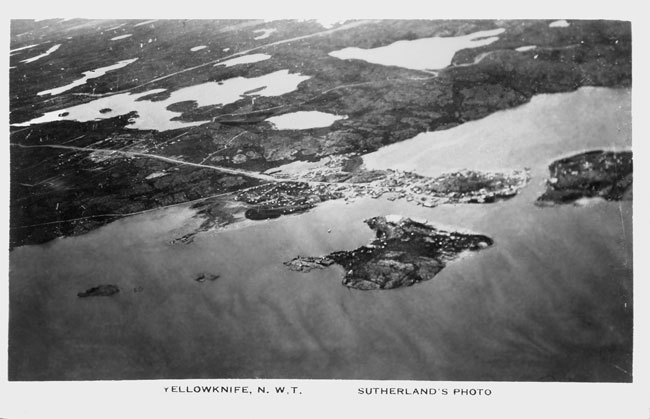
This postcard was donated by Peter Sinclair. The date the photo was taken is unknown.
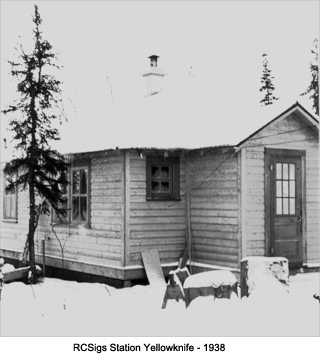
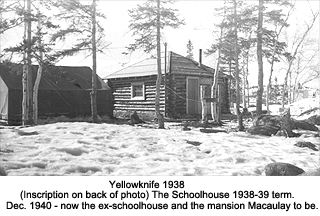
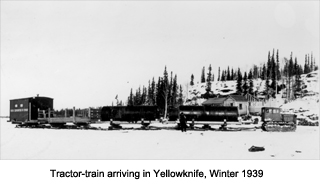
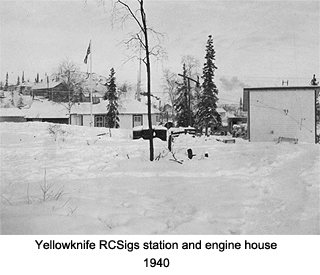
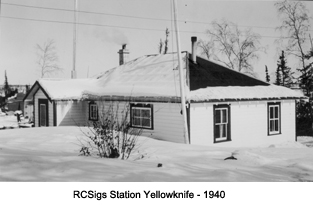
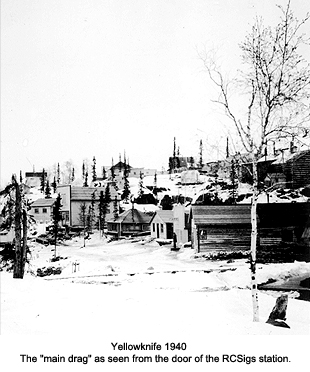
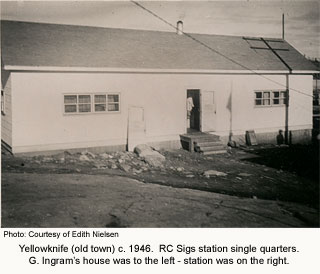
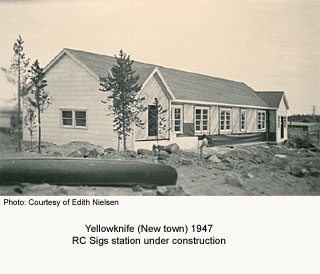
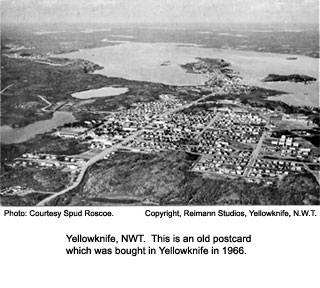
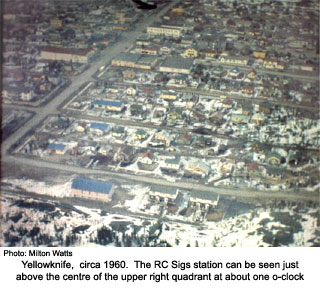
A Brief History of the Yellowknife Station
In 1937 one of the RC Signals stations was located at Fort Rae. The decision was made early in the Fall to close down the Fort Rae station and move it to Yellowknife due to the mining boom there, with its subsequent increase in aircraft activity.
Yellowknife is situated 80 miles southeast of Fort Rae, on the north arm of Great Slave Lake. As the boom activity increased, more and more aircraft for the Great Bear Lake mining fields were being routed via Yellowknife in addition to supplying the local needs. This of course resulted in Fort Rae being by passed and reverting to its pre 1933 status of straight trading and providing a base for a RCM Police post.
SSgt. McAulay and LCpl. Burgess packed all the Fort Rae equipment, which was loaded aboard the Hudson Bay Transport vessel "Dease Lake" and transported to Yellowknife. It arrived there on 15th September. The boys had even been far sighted enough to bring the outdoor privy along as they were none to sure what facilities existed at Yellowknife.
The equipment, consisting of a SITD 100B LF transmitter, Northern Electric 20 watt HF transmitter and two CSR2 Marconi receivers (one of which was modified for long wave), was set up in a tent next to the Camlaren Mines Ltd warehouse. Two 60' angle-iron masts were erected on the bald rock and power was brought into the equipment tent from a Briggs Stratton 1 112 HP 700 watt plant housed in a packing case.
When this work was completed, communications were quickly re-established on the 13th of October with the old Fort Rae outlets namely, Fort Smith, Cameron Bay and Gordon Lake.
A combined station/living quarters building which had been ordered pre cut from Edmonton arrived before freeze up and was quickly set up. The equipment was transferred from the tent. Yellowknife Radio Station, destined to become the largest and busiest on the System, was now firmly and comfortably established, making nineteen stations in full time operation on the ever expanding network as of the year's end 1937.
LONG-DISTANCE RADIOTELEPHONE SERVICE FOR THE COMMUNITY
During 1938 a new radiotelephone service was provided for the general public at the following RC Signals stations: Edmonton, McMurray, Fort Smith, Yellowknife and Goldfields. Repeater equipment was installed in the Edmonton Radio Station with connections to the offices of the Alberta Government Telephones from where local or long distance connections were made in the normal manner.
Telephone booths were installed in the northern stations mentioned, tied in with the HF transmitting and receiving equipment and thus customers were able to converse with friends or business associates in homes or offices in Edmonton or points beyond.
The long distance radiotelephone service was restricted to the Western Provinces for reasons unknown but, nevertheless was greeted and used enthusiastically by mining and transportation companies particularly, and the general public at large, for both business and social calls. Christmas and New Years were especially popular times for such service, all stations being swamped with calls.
This service was improved the following year with the addition of 'scrambler' equipment so that customers could rest assured that their conversation was strictly private and not capable of being intelligently heard by any broadcast listener with a short wave receiver tuneable to the frequency in use.
After the outbreak of war more urgent equipment commitments became greater and greater until finally the long distance telephone agreement with Alberta Government Telephones was cancelled in October 1942 and the service discontinued.
WEATHER FORECAST SERVICES
To improve the weather information available for aircraft involved in the DEW Line airlift, the Department of Transport decided to open a forecast office in Yellowknife in August 1955 and called upon the NWT& Y Radio System of course to handle the large volume of various types of weather reports required for such an office to function. Since the RTT equipment in use was not adapted for the transmission of weather symbols and all weather traffic was handled by the hand keyed circuits, it was not possible to carry out such a commitment fully until such time as the Department of Transport provided weather symbol keyboards for the RTT equipment at Edmonton, Fort Smith, Yellowknife, Fort Simpson and Norman Wells. This was done early in 1956 and full use was made then of the RTT equipment for the dissemination of weather information between the weather office in Edmonton and the four main northern stations.
By 1955 The increase in aircraft movement also created air ground air service problems. RC Signals installations were located anywhere from 4 to 14 miles from the airports at the main northern towns boasting all weather fields so it was becoming increasingly impracticable for them to control aircraft movements at these points. The Department of Transport however was located right at the airports in question, operating Radio Range Stations and doing field maintenance, so it decided that they were in a much better position to exercise the necessary aircraft movement control By the end of May the Department had taken over all air ground air communications at McMurray, Fort Smith and Yellowknife, while Canadian Pacific Air Lines assumed the same responsibilities at Norman Wells. This of course relieved the pressure on the Sigs staffs at these stations a great deal and they were able to handle their other heavy traffic commitments much more efficiently.
COMMUNITY BROADCAST RADIO STATIONS
Shortly after World War II, NWT& Y Radio System had installed and operated low power broadcast transmitters at Whitehorse, Dawson, Aklavik, Norman Wells, Hay River and Yellowknife for the benefit of these communities. This service was of course outside of normal duties and soon became too burdensome for Sigs personnel to cope with so local citizen volunteer committees were formed to assist in the operation of these broadcast stations. .
In 1958, the Canadian Broadcasting Corporation decided that it was their responsibility to provide broadcast services for the residents of the Yukon and Northwest Territories. By year's end the CBC had taken over operational control of almost all remaining stations, including CFYK Yellowknife. The final station,CHAK Aklavik was also turned over to CBC early in 1959.
THE STATION CLOSES
In 1958 at the start of the System Handover to the Department of Transport, countless letters had been received at Headquarters from airlines, water transportation companies, mining firms, government agencies and numberless private individuals, all expressing sincere appreciation for the outstanding services provided over the years and the deep regret at having to say goodbye to Signals in the north. These letters were most gratifying, confirming the knowledge of a job well done.
Yellowknife was chosen as the station at which symbolic ceremonies to officially mark the occasion of the transfer of the System to the Department of Transport would be held. Elaborate preparations were made well in advance and the historic event took place on the 6th of November, 1959.
In the operating room at the Yellowknife Radio Station, Lt. Col. D Grant, CO NWT&Y Radio System, opened proceedings by introducing Col. ET Munroe, representing the Minister of National Defence, the General Officer Commanding Western Command and the Director of Signals. Col. Munroe then addressed the assembly, briefly outlining the System history and terminating his remarks by formally relinquishing control of the System to Mr. HJ "Jeff" Williamson, Regional Director of Air Services, Edmonton District, Department of Transport, representing the Minister of Transport. At this time Col. Munroe wrote a message announcing the relinquishment and handed it to a Sigs operator for transmission to the Minister of National Defence.
Mr. Williamson then spoke to the gathering, acknowledging the fine reputation RC Signals had built for themselves in the north and expressing the vow that his Department would carry on in the same tradition and endeavour to improve upon it if at all possible. He then drafted a message announcing formal acceptance of the System, which he handed to a Department of Transport operator for transmission to the Minister of Transport.
The large crowd then repaired to an unoccupied Married Quarter to partake of refreshments, which had been expertly prepared and laid out invitingly by that peer among chefs, Pte Al Reynolds. Many compliments were received regarding the variety and excellence of the food and many guests were heard to express amazement upon learning that even the perfect French pastries were a product of Reynold's wizardry. Highlighting this reception was the presentation of a mounted, suitably inscribed, silvered Morse Telegraph Key by Col. Munroe to Mr. Williamson, to tangibly mark the occasion of the System handover. Speeches were also heard from such prominent guests as Mr. CL Merrill, Administrator of the Mackenzie, Frank McCall, Area Administrator, "Scotty" Gall, Hudson Bay Company store manager and member of the Territorial Council and "Ted" Horton, Mayor of Yellowknife. All speeches took the same trend, that of eulogizing System personnel, expressing regret at their departure and wishing them well in their future endeavours.
Representatives from the press, radio and TV in Edmonton were also present and gave full coverage to the affair.
Much credit for the success of this Symbolic handover must go to Maj. "Rosie " Larose, 2 IC NWT& Y Radio System, and Lt. Bob Becker, Quartermaster, for the planning and organization, as well as to WO 1 "Red" McLeod and his Yellowknife station staff, along with Sgt Bob Ballantine, Sgt. George Behm and Cpl. Ron Gould of the Edmonton staff, for their active and wholehearted cooperation in the preparations.
With the transfer of Yellowknife completed, the Department of Transport now controlled all the main RTT circuits from Edmonton to the north and Sigs were left with 5 secondary stations. This number was reduced to 4 on the 9th of December with the transfer of Beaverlodge Lake Radio Station. The handover of this station was without doubt one of the easiest for the Audit Team. There were no buildings of any description or power plants to account for as all accommodation and power were supplied by Eldorado Mining & Refining Company thus making it a relatively simple matter of checking the technical and a small amount of office equipment. A similar situation had prevailed at Inuvik, where the Department of Public Works supplied accommodation and power. Revenue from the Beaverlodge station had dropped off considerably in the last year as most of the uranium mining companies were finding it impossible to operate profitably and were closing down. Eldorado Mining & Refining Company planned to continue operations but would be unable to absorb many of the unemployed miners so, at handover time, the future for this area did not look too bright.
Traffic figures for 1959 are only available for the period 1 Jan 1 Jul, at which time the Department of Transport took over the traffic accounting for the System. During this 6 month period, 1,234,471 messages of all types were handled for an estimated value of two and one half million dollars.
The Royal Canadian Corps of Signals assigned tasks of providing public communications in Yellowknife, and throughout the north, had come to and end after 36 eventful years.
Return to top of Page
Back to Stations Page
Go to Yellownife Station [Page 2] [Page 3]Legacy Notes
See Legacy Notes: Radio Stations